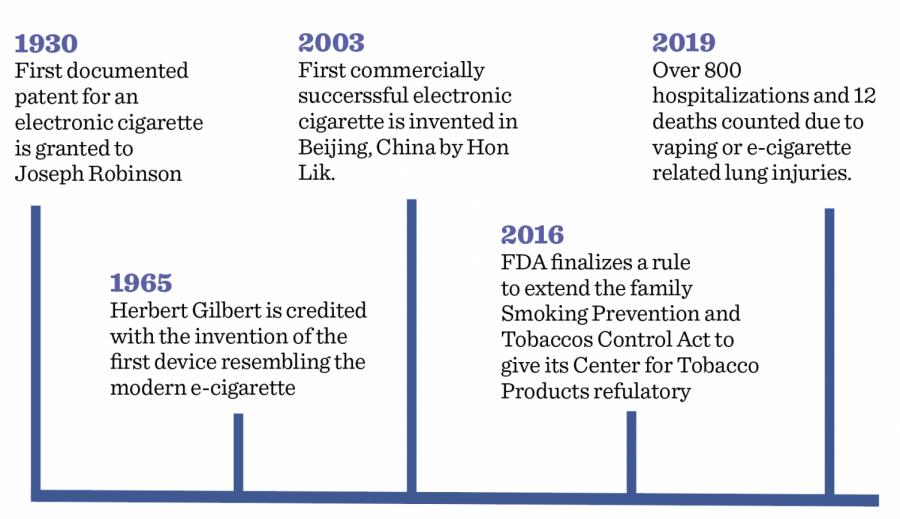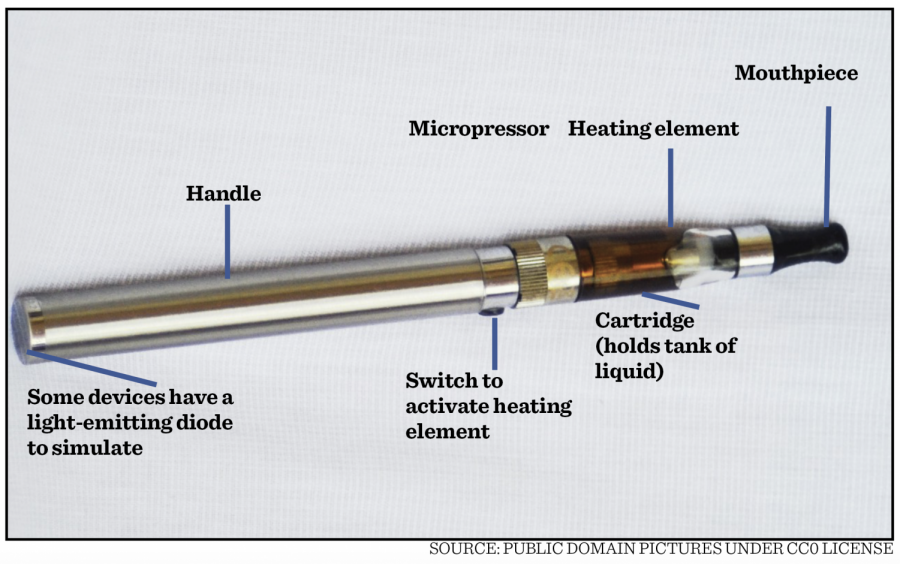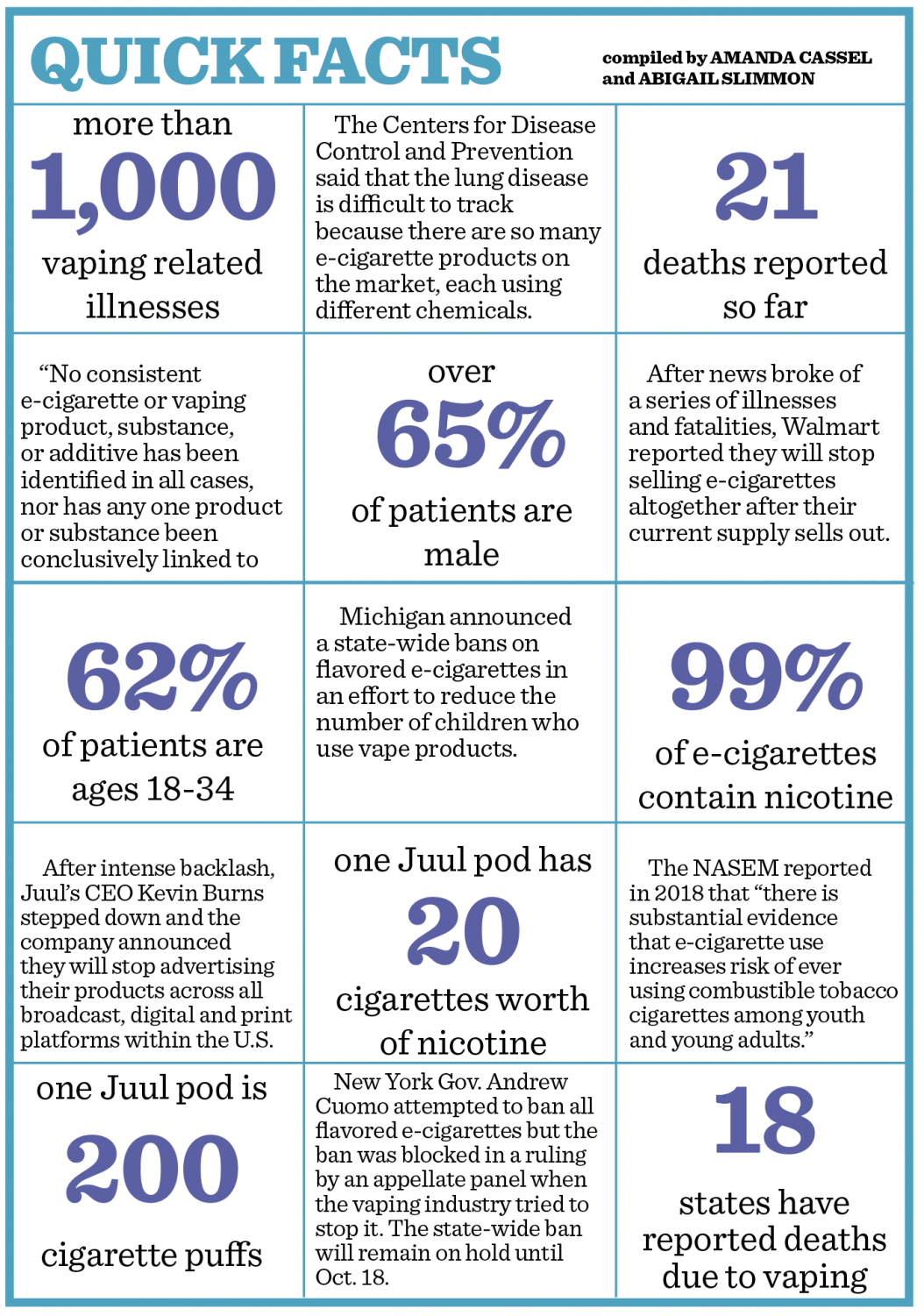Clouded truth: Teen vaping
Teenagers are hooked on vaping and nicotine. With vaping-related deaths and hospitalizations on the rise, being informed is more vital than ever. Officials are realizing vaping can be dangerous. Will teens put down their Juul and put their health first?
October 9, 2019


Background: Traditional cigarettes revolutionized in late 20th century to decrease risk of lung cancer

E-cigarettes may seem like an entirely modern innovation to cigarettes, but different health experts throughout the last century have been searching for a healthier alternative.
E-cigarettes are just the assumed modern remedy, but really, they may cause more immediate damage than the modern cigarette.
According to the Centers for Disease Control, the first e-cigarette was patented in 1965 by Herbert A. Gilbert to be “a safe and harmless means for and method of smoking.”
Since then, the e-cigarette has been modified to be both more energy efficient and contain varieties of potencies, flavors and chemicals.
In the early 2000s, e-cigarettes moved into the U.S. market and throughout the last 15 years, e-cigarettes have gained substantial traction among teens through adults.
The FDA has been seeking to regulate e-cigarettes for the last several years, but legislation has not kept up with the speed of technological advancement.
As a result of this, e-cigarettes have been operating in a regulatory gray-area.
Components: Battery powered, metal e-cigarettes provide easily concealed nicotine source
 E-cigarettes are sourced in a battery with a reservoir containing a solution, typically holding nicotine, a heating element, and can include any variety of flavorings ranging from mango to menthol and other chemicals.
E-cigarettes are sourced in a battery with a reservoir containing a solution, typically holding nicotine, a heating element, and can include any variety of flavorings ranging from mango to menthol and other chemicals.
When the user utilizes the e-cigarette, the device heats the liquid solution or “e-juice” into vapor form for the user to “puff.”
The user consumes the e-juice vapor through a specialized mouthpiece attached to the end of the device.
The nicotine and flavoring chemicals function as solutes in the e-juice, meaning they are dissolved into other chemicals as they take a vaporized form for the user to inhale. These chemicals are what provide the positive sensation associated with these devices.
Flavors have been developed over the last several years to make e-cigarettes marketable to teenagers and young adults.
Dr. King described how in her lectures, she polls the audience asking them if they think they are merely vaporized water, and usually, she explained, about half of the audience has been misled and says yes.
“They don’t even really know what’s in these things,” Dr. King said, “because the FDA doesn’t even know what’s in these.”
Interest, addiction, withdrawl: Amidst recent news, students put down their vaping devices
Two female U-High students each a former vaper, agreed to speak with the Midway on the condition that their names were changed to protect their anonymity.
Here are the stories of “Nicole” and “Bridget.”
“I was shaking. All I could think about was taking another hit,” Nicole said about being addicted to nicotine through a vaping device. “I’ve tried quitting a total of seven times and I really only made it through when I told my friends to physically hold me back from doing anything.”
According to the National Youth Tobacco Survey, high school vaping increased by 78% from 2017 to 2018 — from 11.7% to 20.8%.
“People think it looks cute. People are like ‘Oh wow, this is so cool.’ And it’s so easy, such easy access, I mean you can hide it anywhere,” Nicole said. “It’s so easy not to get caught because you can just put it in your pocket.”
Like Nicole, Bridget also uses a vaping device. The leading brand name, Juul, is so common it’s become a verb for using the device.
Quitting has not been easy. Bridget mentioned that vaping’s prevalence has made it difficult to quit.
With the recent deaths and illnesses it was just kinda a shock to the system, ‘cause I always thought of it as a long-term drawback. Like smoking cigarettes, maybe I’ll get lung cancer when I’m 70. But this is very instant. Like, I could die now, when I am 17.
“I’ve been dependent on it for a couple of years now so just a shock to the system. And especially when it’s so common and people use it everywhere, it’s just kinda hard to escape from,” Bridget said.
To reduce the prevalence of tobacco products, 2009 Congress passed the “Family Smoking Prevention and Tobacco Control Act” allowing the FDA to regulate tobacco products. Vaping has just begun to have regulations. The act mainly affected “Big Tobacco,” or the five biggest tobacco companies in the world.
This past June, San Francisco followed the lead of Congress and began the process of banning all Juuls and e-Cigarette products.
“I think that after the Big Tobacco thing there was an immediate drawback from cigarettes and everyone was, like, ‘OK, cigarettes kill, cigarettes are gross and that’s just kinda how our generation was brought up,” Bridget said.
Unlike cigarettes, the long-term health effects of e-cigarettes remain relatively unknown according to the Centers for Disease Control and Prevention.
“It just kinda shows that all the stuff we read that, ‘Oh yeah, there is not a lot of safety checks or there is not a lot of research that has been done with vaping yet,” Nicole said. “I felt like at first when I started, it started as like, ‘No they wouldn’t put this out on the market unless it was safe.’ And it turned out it’s not.”
Bridget and Nicole both believe that people are more inclined to vape rather than smoke cigarettes because there is less conclusive research to point to long-term health issues.
Additionally, Bridget said she chooses to vape rather than smoke cigarettes because she prefers the taste of her Juul.
In total, there have been 805 lung injury case and 12 deaths in the United States due to vaping; 22% of patients are 18- to 21-year olds, and 16% of patients are under 18 years old.
“I think there have been so few cases that people are like, ‘Well that’s just a freak accident’ rather than if you are dealing with heavy drugs, then, you know, this could kill you here and now,” Bridget said. Despite the recent news coverage, some of Bridget’s friends continue to vape.
Vaping is highly addictive and is unsafe for kids, teens, and young adults according to the CDC.
“The problem with nicotine is that its half-life is so short that you need it. You put it down and you need it right away,” Bridget said. She mentioned a study that she read that showed that nicotine is more addictive than heroin. “It really rewires your brain into thinking you need it.”
Another health risk is that many people who have vaped, including Bridget and Nicole, said that they did not always know what was in their vaping pod.
“A lot of pods you can refill and so a lot of stuff is fake on the market, which is really terrifying,” Nicole said, “but for me, for a while it was like, if I’m desperate enough, I’m going to do it anyway. And that’s when I figured out I needed to stop.”
Both Bridget and Nicole have stopped vaping due to a number of reasons. Chief among them is the recent news coverage of people reportedly dying and having lung injury and illnesses due to their vaping habit.
“With the recent deaths and illnesses it was just kinda a shock to the system, ’cause I always thought of it as a long-term drawback. Like smoking cigarettes, maybe I’ll get lung cancer when I’m 70. But this is very instant. Like, I could die now, when I am 17.”
For young people, e-cigarettes are even more addictive
“Nicotine; it’s a highly addictive drug and the amount that you can get into your brain within nine seconds of taking in one hit on a vape pen or a Juul, can be very high levels just like combustible smoking,” said Andrea King, a psychologist and researcher at the University of Chicago.
Juul’s mission is to be an alternative to cigarettes but has taken over social media and has had a huge influence on teenagers.
Teens think it’s a safer alternative and will not have the same effect on them as cigarettes. These are the messages teens get daily about consuming substances, but the reality is, “At these young ages, the brain is very very sensitive to nicotine work, more so than any time in life,” Dr. King said.

Nicotine; it’s a highly addictive drug and the amount that you can get into your brain within nine seconds of taking in one hit on a vape pen or a Juul, can be very high levels just like combustible smoking.
— Andrea King, University of Chicago psychologist and researcher
She explained that it’s important for teenagers to realize how much faster they can get hooked on these substances.
“Tobacco companies have long known that they want your brain,” Ms. King said. “I say, by age 19, they want your brain, because they know they will have a lifelong customer or could and they when you die, they just find replacements.”
According to Dr. King, vape labels are not required to say what chemicals they hold.
“So the amount of nicotine and the addiction that somebody could have plus these chemicals that we don’t really know because they don’t have to reveal those ingredients can be very scary.”
Dr. King explained that around the world, some countries are setting limits on the amount of nicotine allowed in the e-juice, inserted into the vape.
For example, in the United Kingdom, who’s limit of 20 milligrams per milliliter, the limit is almost two times lower than the chemical composition of Juul pods.
“It has been cited as the equivalent of a whole pack of cigarettes in terms of how much nicotine you would be inhaling in your lungs. It depends a lot on how the person uses the product, some people can take a longer hit and hold the inhale for longer,” Dr. King said.
Dr. King described that because of the amount of gray area from user to user, whether it is their age, how often and how much they consume, or their other habits, it is difficult to talk about what it means to quit and how difficult that process will be.
She described how studies have been completed and methods have been developed to help adults quit.
“We treat adult smokers, and we have medications to help them quit,” Dr. King said. “But, they’re not approved for people under 18, which makes it that much harder to quit.”
Quick facts: Vaping

Social media source of vaping epidemic in teens
On Sept. 25, Juul Labs, Inc., announced that the company would suspend advertising in the United States in response to several medical cases related to e-cigarette use. The Food and Drug Administration has gone as far as to call vaping among young people an “epidemic.”
Despite seeming to know the dangers, millions of teenagers around the world continue to use vaping devices from Juul or another company. According to Sherry Emery, a senior fellow at the National Opinion Research Center at the University of Chicago, this can be credited to the company’s expert marketing tactics.

We saw the emergence of these lifestyle and aesthetic accounts like ‘Juulgirls’ that made memes displaying and promoting Juul usage. Then regular people are reposting those messages.
— Sherry Emery, National Opinion Research Center
“Juul got out there and started posting messages about their product before anyone else, but they did it in a way that followed the playbook of cigarette companies,” Dr. Emery said.
One part of what she and her team do is study old cigarette advertisements and compare them to those of Juul and other vaping devices.
“They appeal to teens using the same strategies. They have advertisements featuring youthful models and appeal to certain lifestyles, sexuality and independence,” she said.
But what sets Juul apart, according to Dr. Emery, is Juul’s use of social media as a marketing strategy. She said that after their initial launch, “we saw the emergence of these lifestyle and aesthetic accounts like ‘Juulgirls’ that made memes displaying and promoting Juul usage. Then regular people are reposting those messages,” she said. “There are tons of memes, references to Juuling in school, and making addiction trivial and glamorized. It’s not shocking for youth because they see it every day. For everyone else, it’s completely foreign.”
The companies “Adults and policy makers aren’t seeing it because now it’s mixed into the social media culture that only kids are a part of.”
She said Juul’s unprecedented success is largely due to these marketing tactics as well as the high content of nicotine present in their products. Older e-cigarettes had a lower concentration and were less efficient at delivering nicotine.
“The design of the products just made it very appealing, and when you pair that with excellent marketing strategies, it’s the perfect storm,” she said.
Dr. Emery pointed out several factors contributing to teens vaping less.
“The Truth Initiative is a group right now that’s trying to provide health for vaping and nicotine addiction,” she said.


Zainab Baig • Oct 10, 2019 at 8:29 am
Excellent and well researched article!
Faculty should consider incentivizing all students in middle and high school to read it and discuss it with their parents…
Extra credit? Discussion in advisories? Poster contest ?